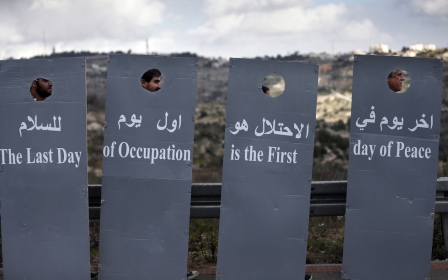Legitimising racism in Israel in 10 steps

Step 1: A scoop is born
On 29 March, a reporter revealed that some Israeli maternity wards segregate Jewish mothers from Arab ones after birth. In some hospitals, the staff talk about the practise in code, referring to Jewish mothers as “our own” as in: “I am bringing up from the delivery room to the ward one of our own." Arab women are: “A (Arabic) speaker,” as in: “I am bringing to the ward an A speaker.”
Step 2: Thank god for the racist
The reaction was one of shock and disgust - on the whole. However Bezalel Smotrich, deputy speaker of the Knesset, did not see anything wrong because, in his words “after giving birth, my wife wants to rest, she doesn’t want noisy visitors and parties.” For anyone doubting his meaning, he later clarified that “my wife would not want to lay next to someone who just gave birth to a baby that will want to murder her baby in 20 years.”
Step 3: The cleansing
Once out in mainstream media, everyone was appalled by what this racist member of the Knesset had said and felt good about themselves. We are not racists, we would never say anything so disgusting. Even the head of his own party said that he was shocked. He had just nursed his sick father in the hospital, who lay next to an Arab patient. They shared the same fate and desire to get well.
Step 4: Denial
In hospital we are all equal, or so we all believe. Hospitals are seen as a safe haven and to a large degree they are. As the debate continued, I was worried that the focus would remain on the comments of one racist, who would be outcast, thus allowing the rest of us to cleanse ourselves. In the process the more important debate about institutional racism and discrimination would be neglected.
It is easy to talk about “the ugly racist”. It is more complicated to talk about the system. Even medical professionals keep silent and buy into the myth that the “hospital is a moral space”. It is not considered racist when patients ask to be with people who are ‘like them’. And what if a Jewish patient asks not to be treated by an Arab doctor or nurse? Is that where we are heading?
Step 5: The role of media
Public radio picked up the debate and did not let it die. Morning news shows interviewed medical professionals and human rights activists. The racist MP opened the door to a discussion that refuses to be silenced.
Step 6: Learning about the issue
Separation is not new. I encountered it when I gave birth 20 years ago. Without asking, I was brought to the “Jewish room”. It was in the news in 2006, and again in 2012, following an extensive inquiry. In 2013 the Israeli human rights organisation Physicians for Human Rights (PHR) conducted an investigation on separation in maternity wards which followed with an official complaint to the Israeli Medical Association. The written answer PHR received was that the association checked with the hospitals and there is no policy of separation. They wrote that women are given rooms according to their medical needs and not according to their identity. The association sees equality as an important value in the public medical services…in March 2016 PHR published a brave report called Racism in Medicine, including a chapter on maternity wards.
It seems that the health institutions are not ready to deal with the information that is being presented to them.
Separation is the symptom of a much bigger problem - racist practices in public medicine. The PHR report describes racist practices in medicine through the years. Their report mentions the involvement of medical staff in the kidnapping of Yemenite-Jewish babies in the early 1950s, discriminatory practices toward Ethiopian-Jewish women, concerning birth control methods, and more.
Unlike some laws in Israel, in the field of health the letter of the law is clear - discrimination of any kind is forbidden. The problem is not with the laws but with the gap between the laws and daily life. When I say daily life, I am not referring to unfortunate, marginal incidents but to ongoing, unspoken practices.
The reason the issue of separation came up specifically with maternity wards is that hospitals compete over women who give birth. This is a good income for the hospitals, and in their attempt to get more “clients”, they try to cater for women’s every desire, Including separate rooms.
Step 7: Separate but not equal
What have we learned? We learn that “separate but equal” does not work. It never did, and it’s a myth. The picture that was exposed is the tip of deeper discrimination. In her research on inequality in public health, Dr Nihaya Daoud showed how in Israel, like in other developed countries, there are ethnic gaps in health between the majority group and minority groups, be they indigenous, immigrant or gender minorities. She suggests that the first step is to acknowledge these gaps, and then to try and close them.
Her research showed that In Israel, the health of Arab citizens has become better in the last decade. At the same time, the gaps between Jewish citizens and Arab citizens have become wider. The gaps are especially high when we look at infant mortality, chronic diseases, and life expectancy.
Step 8: Some recognition
The racist of the week helped. One week into the row, the Ministry of Health announced that it will call hospital directors to a meeting on the matter. Two weeks into the storm a parliament committee conducted an emergency meeting on the issue. This is when we learned that in addition to Jewish women who ask not to be with Arab women, Arab women also ask for separate rooms because they are afraid of Jewish women. Religious Jewish women ask not to be with secular Jewish women, and white Jewish women ask not to be next to black women. The notion we got from the discussion was that if everyone wants it, it’s not racism.
Step 9: Local activism
One month later PHR together with a campaigning organization for social and political change put up a billboard against separation in one specific hospital. After 24 hours the city council where the hospital is located asked to put the sign down because “it is offensive”.
Step 10: Acknowledgment
There is no doubt that the discussion was deeper and longer this time around.
The Ministry of Health may have realised something about the symptoms, but has not acknowledged the problem. If the state discriminates, it is not likely that the health services will be remain immune from the overall toxic atmosphere. It seems that the ministry is waiting quietly for the issue to die. Seeing the depth of denial when it comes to racism, the ministry has a good reason to wait. We will probably need more than a good investigation, a morning radio show and a racist to create meaningful change.
- Michal Zak is a political educator, expert in Jewish-Palestinian dialogue and a resident of the Palestinian–Jewish community of Wahat al Salam-Neve Shalom in Israel.
The views expressed in this article belong to the author and do not necessarily reflect the editorial policy of Middle East Eye.
Photo: Israeli Prime Minister Benjamin Netanyahu gestures as he delivers a speech during an event in Jerusalem on 31 March, 2015 (AFP).
Stay informed with MEE's newsletters
Sign up to get the latest alerts, insights and analysis, starting with Turkey Unpacked
Middle East Eye delivers independent and unrivalled coverage and analysis of the Middle East, North Africa and beyond. To learn more about republishing this content and the associated fees, please fill out this form. More about MEE can be found here.





